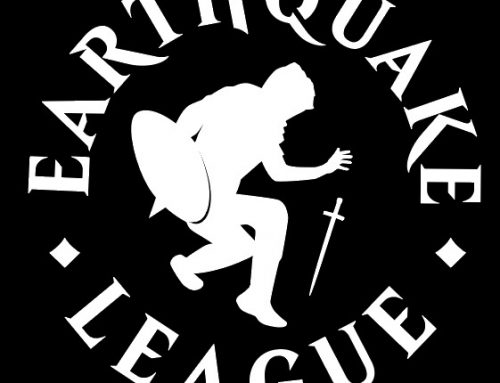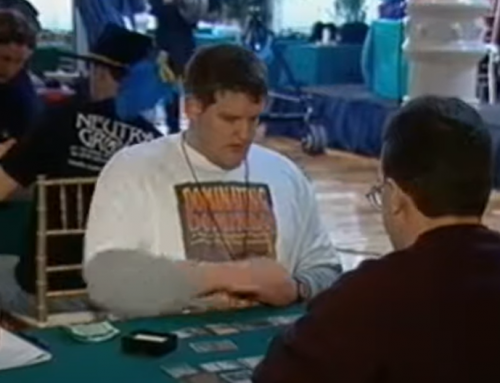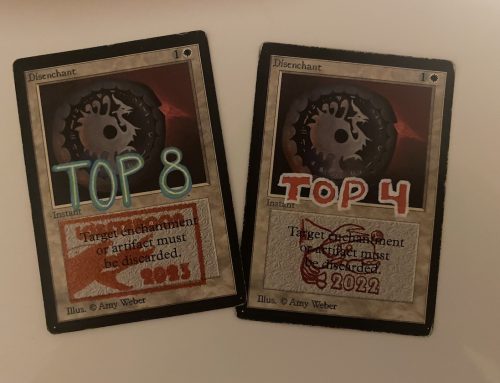One of the joys of old school is brewing. While there are several established top tier decks, the format is still not thoroughly explored. One of the reasons is that there is no professional scene, so we do not have highly organized pro teams exploring every possible corner of the format. Another reason is that in many tournaments there is an explicit incentive for people people to try to come up with new, spicy brews. Moreover, for the first of the reasons mentioned, even top decks might not be extremely well-tuned. All of this makes the correct construction of a good mana base for your deck a necessary task for many players. The construction of a good mana base is the first constraint to our brewing possibilities, so it has wide implications for defining a format.
In this article, I will go over the mana base possibilities the OS format has in this regard, and look through the possible combinations of cards that could optimize your mana base. I will start by mentioning the most relevant mana-producing cards in the format. I will then turn to the types of decks that you could want to play. Next, I will try to work out some rules for how to best construct a mana base for your deck. To this end, I will piggyback on Frank Karsten’s popular articles. We will use two articles: one discussing the minimum number of lands needed to hit your land drops (link), and another discussing minimum amount of colored mana of each kind needed for a certain degree of consistency. Then, we will apply these lessons to our beloved OS format. In each case, we will study how the suggested rules fit the decks of some recent tournaments.
On this first part of a series of articles we will cover mana bases for monocolored decks. On a second part we will go over mana bases for multicolor decks.
Mana-producing cards
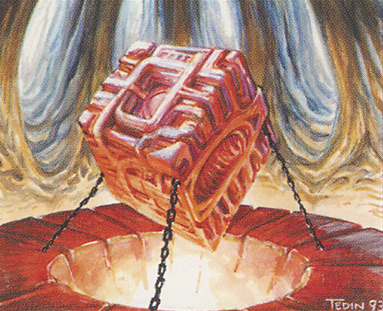
Mana Vault, by Mark Tedin
- Fast artifact mana: Many OS decks will want to fit in the basic speed-artifact package: all the five moxen, a lotus, and a sol ring.
- Colorless lands: OS has plenty of excellent powerful utility lands to choose from. Almost all decks will want to include 1 Library of Alexandria. Most decks also use 4 Mishra’s Factory. Depending on the specifics of the banned list you are playing with, you could also have access to 1 or 4 strip mines, and have access to 1 to 4 Mishra’s Workshops.
- City of Brass: city is an unsung hero. A format-defining card that greatly expands the deck construction possibilities.
- Duals
- Basics
- Dorks: Birds and Elves
- Dark Rituals
- Mana Vaults
- Fellwar Stones
There are many more cards (sorry Sisters of the Flame!), but we will focus on the ones above to keep the complexity and the number of possible combinations in check.
Then, we should start thinking about the types of decks could play. I will discuss the following deck groups:
- Mono White, Mono Blue and Mono Red decks
- Mono Black decks that can use rituals
- Mono Green decks that can use elves
- Two-color decks (e.g. UR aggro-control, BW aggro)
- Two color splash blue decks (e.g. Esper)
- Aggressive decks with Kird Ape
- 5-color control decks (e.g. The Deck)
Karsten’s Suggestions
For this article, we will use Frank Karsten’s calculations of how many colored lands you need in a deck to be able to consistently cast your spells, conditional on having the right number of total lands. Consistently is defined as being able to cast your spells on 90% of the cases. The following table is extracted from Karsten’s articles, the only change being that we don’t need columns for 40 or 100- card decks, and we use much cooler cards as examples. Example for a 3 colorless, 1 colored mana Collected Company? Make that The Abyss, please!
| Mana Cost | Example | Number of required sources |
| 3C | The Abyss | 10 |
| 2C | Stone Rain | 11 |
| 1C | Demonic Tutor | 13 |
| 4CC | Shivan Dragon | 13 |
| C | Birds of Paradise | 14 |
| 3CC | Serra Angel | 14 |
| 2CC | Juzam Djinn | 16 |
| 3CCC | Amnesia | 16 |
| 1CC | Hypnotic Specter | 18 |
| CC | Lord of Atlantis | 20 |
| CCC | Ball Lightning | 23 |
The table above is constructed assuming that the deck has 24 lands, and that you have drawn the right number of cards. So, for example, for Birds of Paradise you would say: if my deck has 24 lands, how many green-producing lands do I need to be able to cast my birds on the first turn? – and the answer, as the table indicates, is 14. (as we all know, the bird is going to be killed by a bolt on the opponent’s turn, so why even bother?)
The most important thing to notice here is that Karsten’s calculations assume that you have drawn enough total lands. On a separate article he discusses how many total lands you need to use, and we will go over that too. The 24 lands in the deck part is less important than it seems, precisely because we are conditioning on having drawn enough lands. I think the most important caveat here is that if your deck has significantly more than 24 lands (e.g. The Deck and its 30 mana sources), conditional on having drawn at least N lands, there is a higher chance that you actually drew more than N lands. In that case, your chances of getting the right mana colors are slightly better than the ones appearing on the table above.
Mono White, Mono Blue and Mono Red Decks
These are easier. We will pull straight Karsten’s suggestions here. If you are an aggressive deck, you want be able to cast your guys right from the start. With 14 plains in your deck, those Savannah Lions can go down with a 90% probability, so you can feel free to indulge on factories and strip mines. Same goes for burn decks wanting to cast their bolts since the very first turn (for the birds, obviously). However, if you also want to cast some knights with a similar consistency, things are quite a bit harder. You would need no less than 20 sources of colored mana to cast them. Same applies for blue decks planning on casting their counterspells in turn 2. This is a steep requirement!
Let’s take a look at a successful list and see how it does the mana dance. Elantris’ Goblin Deck from the Vegas OS event is a thing of beauty. This is one of the few mono-colored decks making the top of recent events. Kudos to Athena for this feat, and let’s see what she has.
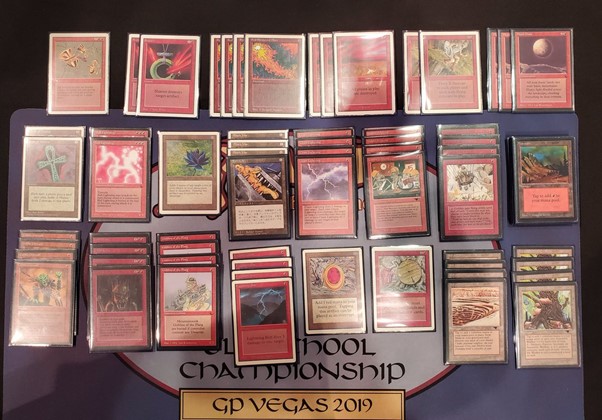
Mono Red, Top 8 Vegas OS Tournament 2019, by Athena
Based on the total cards displayed, I calculated Athena used 37 spells, one lotus, one mox and 21 lands (23 mana sources). Of those lands, 4 were factories and 4 were strip mines. Thus, she is using a number of mana sources that is close to the 24 in the assumptions, so our calculations apply well. Out of her 23 mana sources, exactly 14 are reusable sources of red mana. If Athena had been just casting goblins, it would exactly match Karsten’s suggestions for colored mana sources. However, if you look to the left of the picture, you might find the single most demanding mana sink in Old School: Athena ran two Ball Lightnings. My guess is that for that card, she chose to sacrifice consistency for power. Probably in several games she was stuck with them in her hand, or had to wait until turn 5/6 to cast them.
Let’s take another example, the runner-up for the spiciest deck in the last Lobstercon, “Ron Jeremy AKA Big White Deck”, by Jason Dupre. Jason runs Swords to Plowshares, Knights and Angels. The steepest mana requirement among those is the number of plains needed to cast Knights on turn two. According to Karsten’s suggestions, 20 colored mana would be needed. That’s a lot of plains! Jason only decided to run 16 colored sources. The candelabra in his deck could have been helpful at casting the more demanding cards.
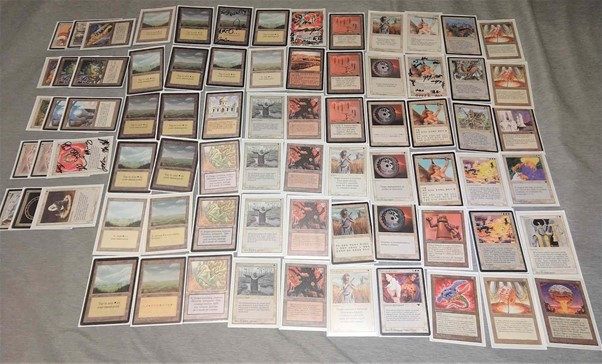
Big White Deck, Lobstercon II 2019, by Jason Dupre
Christopher Taylor’s Mono Red Atog Deck from the Old School Player’s Ball 2019 is another good example. Although the pics are not very readable, it seems he packed 14 mountains. He also seems to have added some fast mana artifacts, but his number of reusable red sources should be close to 15. This deck in in the lower end of mana requirements, and his list fits Karsten’s suggestions more closely than the two previous examples.

Mono R Atog, Top 8 Player’s Ball 2019, by Christopher Taylor
Mono-Black decks with Rituals
Now we have a slight variation on our resources: while we need to get the first black mana for the Ritual, having them in hand implies that we can have our black mana problems solved. If that is true, we could reduce the total number of Swamps, and use utility lands more comfortably.
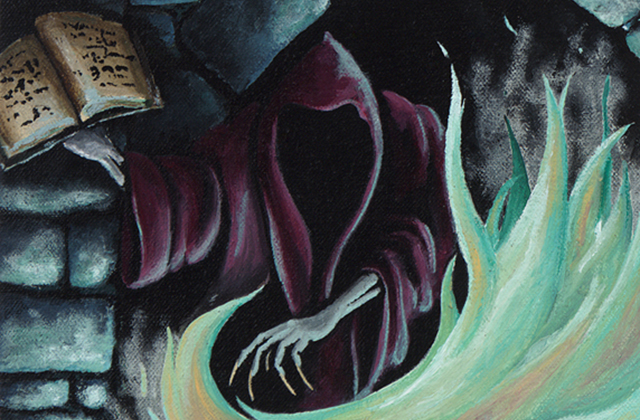
Dark Ritual, by Sandra Everingham
Let’s look at what successful Mono Black decks do in practice. Under ATL rules, Christopher Mason cruised through the top 8 of the New England Old School September league. Although he has steep mana requirements (he always needs two black mana in the second turn), he decided to run the full ATL set of the top utility lands: 6 colorless. This means that he does not get to the suggested number of 20 Swamps for consistency suggested by Karsten, running only 16 Swamps and a Mox Jet. My guess is that the lotus and the four dark Rituals often helped Christopher solving colored mana issues. Adding those, he has the 20 required sources for the 2nd turn play. I wonder how low in Swamps would mono black players be willing to go under the EC rules. If they play Hymns, Hippies and Juzams, they have steep colored mana requirements every turn. If we still count the Rituals and the Lotus as colored mana, that would count towards 5 of the 20 mana sources required for consistency. Thus, mono black players should not go under 14 Swamps and a Mox Jet. Having 20 mana sources already, for a deck that is not demanding in colorless mana, it would probably be wise to limit the number of colorless lands to 6, 5 or less. Leaving Factories or Strip Mines out is a tough decision to make.
Mono Black, Top 8 New England OS League Sept 2019, by Christopher Mason
Mono-green decks with Elves
Naturally, the first Forest becomes much more important for these decks. The rest of the drops are easier thanks to the Elves, so we will focus only on the number of Forests needed to consistently cast the Elves on the first turn, and how it reduces the probability of fizzling in the following turns. As we said, if you have a land in your opening hand, you would only need 14 green sources in your deck to have a 90% probability of being able to cast the Elves. The number of utility lands that you want to include should depend a lot on the colorless requirements of your deck. In a ramp-style deck, it is probably a good bet to include all the top 9 colorless lands in the EC rules (Library, Strip mines, Factories). In a stompy style deck, probably less than that is necessary to cast your spells, but the Factories and the Strip Mines should have enough utility in that deck to warrant their inclusion anyway.
Below is Nikita Shelest’s very cool Monogreen stompy deck. It actually packs 15 sources of green mana, very close to Karsten’s recommendation to cast the Elves consistently. How does having the Elves in your deck change the probability of being able to cast those Whirling Dervishes on your second turn? Depending on your assumptions, my guess would be “a fair bit”. Let’s say the Elf survives until the second turn 75% of the times (if it was Birds of Paradise, we all know the number would be zero). Then, we can roughly say that we have 3 more sources of green mana. That would take the count from 15 to 18. Not quite the 20 recommended by Karsten, but quite close.
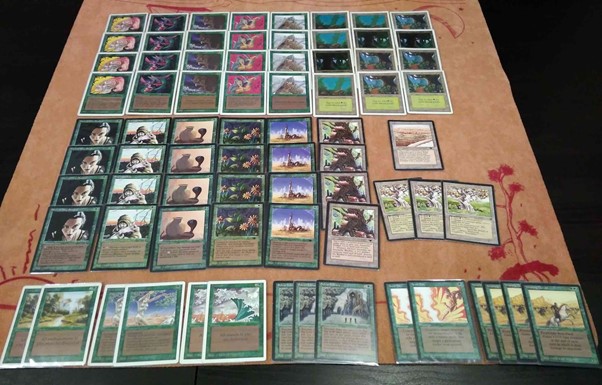
Mono Green, n00bcon 2018 , by Nikita Shelest
Conclusion
As we have discussed, there is a big range of different intensities in the use of mana in mono-colored OS decks. My rules of thumb would be:
- If you don’t need CC casting costs and are playing under EC rules: be happy with 13 basics and a Mox! Indulge in Factories and Strip Mines at will.
- If you don’t need CC casting costs and are playing under ATL rules: again, 13 basics and a Mox is a sweet spot. You will probably be playing 4 Factories, 1 Library and 1 Strip Mine. Whether you include more lands probably depends on the amount of colorless mana you need, which can be your real constraint in this case.
- If you need CC casting costs on time and are playing under EC rules: You need around 20 colored mana-producing lands, so if you don’t have a huge need for colorless, you need to leave out some Factories and some Strip mines. Look at Karsten’s article on the total number of lands for this. For example, for 90% probability of having three lands on turn three on the play, you don’t need to be playing more than 25 mana sources. If you already have 20 sources of colored mana, and you are using Sol Ring (I hope you are!), you only need the mana from 4 colorless-producing lands.
- If you need CC casting costs and you are playing under ATL rules: same as above, but your decision is easier, as you can’t play 4 Factories and 4 Strip Mines anyway.
In the next article I will discuss multicolored decks, featuring the powerful dual lands and the glue of all the greedy mana bases, City of Brass. Stay tuned to the Earthquake League!


